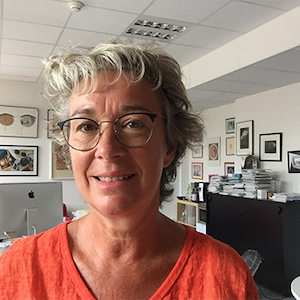Article
LANDSCAPE Study Examines Real-World Management of nAMD Over 10-Year Period
Author(s):
Presented at ARVO 2023, the nationwide data on nAMD real-world management in France suggest a discrepancy between avoiding the undertreatment of nAMD and the real-world management of the disease.
Professor Catherine Creuzot-Garcher
Credit: DMLA

Results from the LANDSCAPE trial suggest patients with neovascular age-related macular degeneration (nAMD) in France are well-monitored by their ophthalmologist, with a median follow-up of 7 years.1
Over a 10-year period, from 2008 - 2018, data showed the median anti-vascular endothelial growth factor (anti-VEGF) treatment duration was 10 months, with nearly half of the patients stopping treatment within 1 year of treatment initiation. Additionally, optical coherence tomography (OCT) became the routine imaging to diagnose nAMD.
“These results emphasized the discrepancy between the need to avoid undertreatment of nAMD and the management of nAMD in real-life study,” wrote the investigative team.
The research was presented at the 2023 Association for Research in Vision and Ophthalmology (ARVO) Annual Meeting in New Orleans, Louisiana.
Led by Professor Catherine Creuzot-Garcher, Centre Hospitalier Universitaire Dijon Bourgogne, the study aimed to describe the patient journey in nAMD for the entire population in France between 2008 - 2018. The retrospective, longitudinal study used exhaustive nationwide population health records of the French National Health Information Database (Système National des Données de Santé).
Creuzot-Garcher and colleagues identified individuals treated for nAMD from the French population aged 50 years and older, with criteria including diagnosis of nAMD or reimbursement of nAMD treatments (anti-VEGF injection or dynamic phototherapy with verteporfin). Contrastingly, exclusion criteria included high myopia, other retinal diseases diagnosis, and treatments for other macular diseases (dexamethasone implant, laser).
Between 2008 and 2018, investigators identified 342,961 patients treated for nAMD. They noted that prior to the nAMD treatment initiation, 59% of patients in 2008 and 87% of patients in 2018 had OCT imaging. Meanwhile, fluorescein angiography decreased steadily from 54% in 2008 to 23% in 2018.
The analysis showed the median duration of ophthalmological follow-up was 7 years (90 months). The median annual number of consultation eye visits decreased from 9 visits in Year 1 after treatment initiation to 4 visits from Year 7 and beyond. Of patients treated during a median of 10.1 months, 48.5% of patients had treatment under 1 year, compared to 24.4% of patients who maintained their treatment at their 11th year.
Creuzot-Garcher and colleagues indicated the median number of anti-VEGF injections was 4 in the first year and 4 every year throughout the 10-year study period in those remaining under treatment. They suggested that first-line treatment is more common with ranibizumab (67.5% of patients) than with aflibercept (32.4%). Data showed nearly 20% of patients who initiated treatment switched treatments at least once.
“LANDSCAPE provides exhaustive nationwide data on nAMD real-world management in France over a 10-year period,” investigators wrote.
References
- Creuzot-Garcher C, Srour M, Baudin F, Dot C, Ngheim-Buffet S, Girmens J, Collin C, Ponthieux A, Delcourt C. Management of neovascular age-related macular degeneration treatment in France from 2008-2018 – the nationwide LANDSCAPE study. Presented at the 2023 Association for Research in Vision and Ophthalmology Annual Meeting; April 2023; New Orleans, LA




